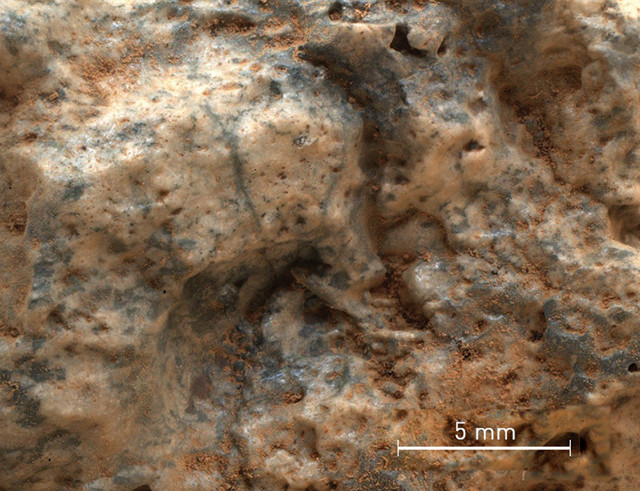
by Timothy Oleson Friday, October 23, 2015

Light-colored and silica-rich quartz and feldspar crystals appear in this dioritic rock photographed recently by Curiosity's Mars Hand Lens Imager. Credit: NASA/JPL-Caltech/MSSS.
With two rovers patrolling the surface of Mars, five spacecraft orbiting above it, and scientists here on Earth studying the Red Planet from afar, new findings are announced often. Here are a few of the latest updates.
A study of 22 igneous rock samples in Gale Crater has shown an unexpectedly wide range of compositions, with some reminiscent of Earth’s silica-rich continental crust. Mars’ crust is predominantly made of silica-poor basalt formed by melting of mantle material and which is more similar to Earth’s oceanic crust. Recent detections of isolated silica-rich rocks have, however, been made remotely by the Mars Reconnaissance Orbiter. The current study suggests that some of the rocks analyzed by Curiosity’s ChemCam instrument are compositionally and petrographically similar to quartz diorites or granodiorites on Earth, thus offering the first close-up evidence of such silica-rich rocks on the Red Planet. It’s unclear as yet how the rocks — all thought to be Noachian (3.7 billion to 4.1 billion years old) in age — might have formed. But regardless “of their formation process, our data point to the possibility of generating ‘continental’ crust on Mars, making the early geologic history of Mars much more similar to that of the Earth than acknowledged at present,” Violaine Sautter of the National Museum of Natural History in Paris and her colleagues wrote in Nature Geoscience.
Traces of methane have been found in Martian meteorites, suggesting that Mars’ subsurface could hold a life-supporting reservoir of the gas, according to a new study in Nature Communications. Nigel Blamey of Brock University in Ontario, Canada, and colleagues sampled six meteorites bearing mafic minerals like olivine and pyroxene and known to have come to Earth from Mars. As each sample was crushed, methane was one of the most abundant gases released, along with carbon dioxide, hydrogen and others. Suggesting that the methane most likely formed on Mars through aqueous alteration of abundant subsurface basalts — a process known to produce methane abiotically on Earth — the researchers ruled out alternative explanations, including that it was generated during the impacts that ejected the meteorites from Mars or that it was due to terrestrial contamination. The new find indicates that a methane-bearing subsurface habitat is available on Mars. “Whether or not the habitat has been occupied remains to be determined,” the team wrote.
The abundance of Martian surface features apparently shaped by running water has led many scientists to speculate that early Mars’ climate was predominantly warm and wet, similar to Earth’s today. A new study, however, indicates Mars was more likely cold and icy several billion years ago. Using a 3-D global climate model, a team led by Robin Wordsworth of Harvard University simulated precipitation patterns on Mars when the planet’s average global temperature was either relatively warm (10 degrees Celsius) or frigid (minus 48 degrees Celsius). The team also accounted for a less intense sun, greater greenhouse warming in the Martian atmosphere, and variations in the tilt of Mars’ axis, each of which affect the amount of solar radiation reaching the planet. In the warm scenario, areas predicted by the model to receive high rainfall did not match well with observed locations of prominent valley drainage networks. Snow and ice accumulation in the cold scenario, meanwhile, offered a better match to these features, the researchers reported in the Journal of Geophysical Research — Planets. They noted that transient melting of ice — possibly due to a combination of volcanism, impact events, orbital variation or other factors — could explain the occurrence of features such as ancient lakes, formed by liquid water.
© 2008-2021. All rights reserved. Any copying, redistribution or retransmission of any of the contents of this service without the expressed written permission of the American Geosciences Institute is expressly prohibited. Click here for all copyright requests.